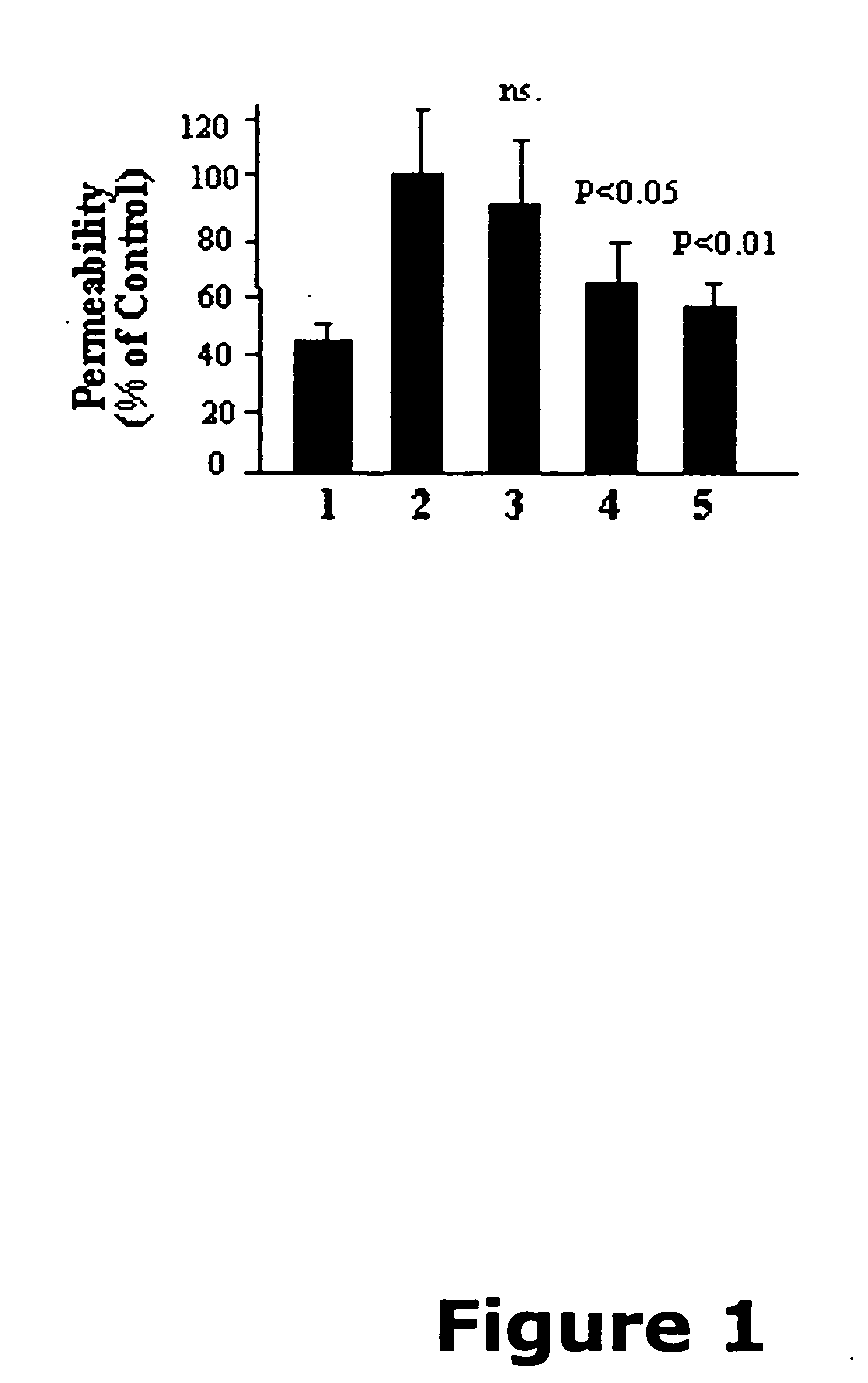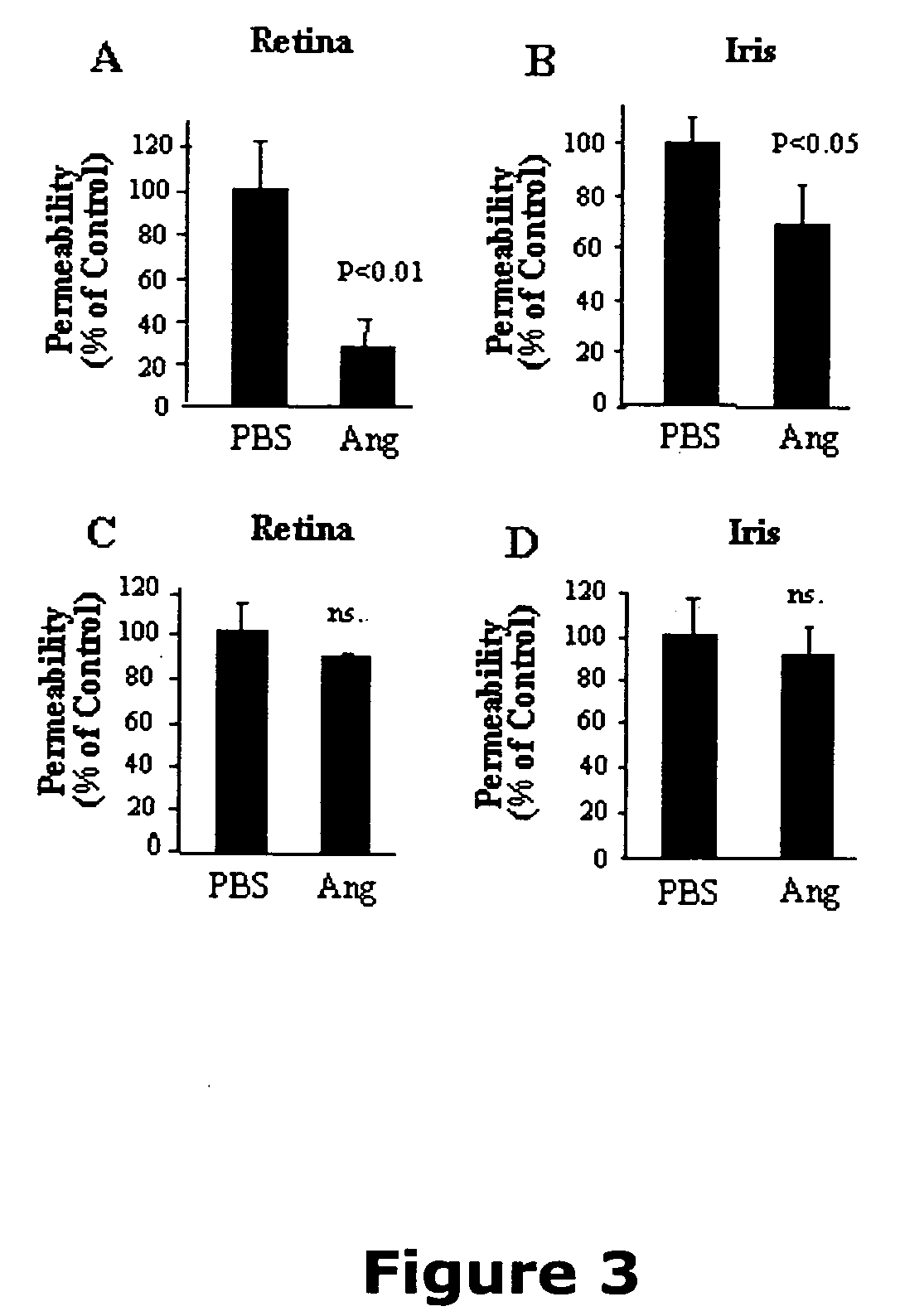Compounds useful in inhibiting vascular leakage, inflammation and fibrosis and methods of making and using same
a technology of vascular leakage and compounds, which is applied in the field of compounds useful in inhibiting vascular leakage, inflammation and fibrosis and methods of making and using same, can solve the problems of insufficient prevention of diabetic patients and vision loss
- Summary
- Abstract
- Description
- Claims
- Application Information
AI Technical Summary
Benefits of technology
Problems solved by technology
Method used
Image
Examples
example 1
Effect of Angiostatin on Vascular Leakage and VEGF-Expression in Rat Retina
[0122] Now referring to the Figures, FIG. 1 illustrates that angiostatin reduces vascular permeability in the retina of OIR rats. Previous studies have shown that OIR rats have a transient increase of retinal vascular permeability with the peak at age P16 (Zhang et al., 2004). To determine the effect of angiostatin on vascular permeability, OIR rats (P14) received an intravitreal injection of 3 μl of angiostatin with different concentrations into the right eyes, to reach doses of 1.875, 3.75 and 7.5 μg / eye. The same volume of PBS was injected into the left eyes for controls. Vascular permeability was measured at P16 using the Evans blue method. In the eyes injected with angiostatin, vascular permeability was reduced in an angiostatin dose-dependent manner. At doses of 3.75 and 7.5 μg / eye, angiostatin decreased the permeability to approximately 70% and 50%, respectively, of the contralateral control with PBS ...
example 2
Effect of Angiostatin on Vascular Leakage, TGF-β Expression and VEGF Expression in Diabetic Nephropathy
[0134]FIG. 6 illustrates the natural existence of angiostatin in rat kidney and a decrease in angiostatin levels in diabetic kidney. Angiostatin as an endogenous angiogenic inhibitor has been found at high levels in the serum and urine of cancer patients and tumor-bearing animals (O'Reilly et al., 1994; Cao, 1999). However, there are few reports on the levels of angiostatin in normal tissue, such as kidney, liver and retina. In Example 2 of the present invention, the existence of angiostatin was first demonstrated in the kidney as well as in the liver and retina in normal adult BN rats by Western blot. The results showed that high levels of plasminogen and proteolytic fragments existed in the kidney and liver (FIG. 6A). Two fragments of angiostatin of the molecular weight of 50 kDa and 38 kDa were found in the kidney, but only the 38 kDa angiostatin was found in the liver (FIG. 6A...
example 3
Effect of PEDF on Vascular Leakage, Vascular Permeability and Inflammation in Diabetic Nephropathy and Diabetic Retinopathy
[0156]FIG. 14 illustrates high-level expression of PEDF in the kidney of normal rats. PEDF was recently found to be expressed in the kidney as well as in other organs, but its expression levels and cellular localization in the kidney have not been determined previously (Abramson et al., 2003). As the liver is regarded as the major source of systemic PEDF (Uehara et al., 2004; and Tombran-Tink et al., 1996), and the retina is a well-known site of PEDF expression and function, PEDF levels in the kidney were first compared with those in the liver and retina. Western blot analysis showed that PEDF in the kidney was at a level comparable to that in the liver and much higher than that in the retina (FIG. 14A). Quantitative analysis using ELISA confirmed the results from Western blot analysis (FIG. 14B). There is no significant difference between PEDF levels in the ki...
PUM
| Property | Measurement | Unit |
|---|---|---|
| Composition | aaaaa | aaaaa |
| Toxicity | aaaaa | aaaaa |
Abstract
Description
Claims
Application Information
 Login to View More
Login to View More - R&D
- Intellectual Property
- Life Sciences
- Materials
- Tech Scout
- Unparalleled Data Quality
- Higher Quality Content
- 60% Fewer Hallucinations
Browse by: Latest US Patents, China's latest patents, Technical Efficacy Thesaurus, Application Domain, Technology Topic, Popular Technical Reports.
© 2025 PatSnap. All rights reserved.Legal|Privacy policy|Modern Slavery Act Transparency Statement|Sitemap|About US| Contact US: help@patsnap.com



